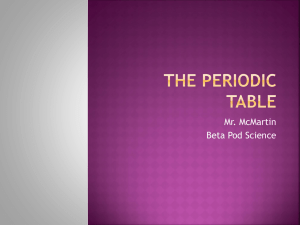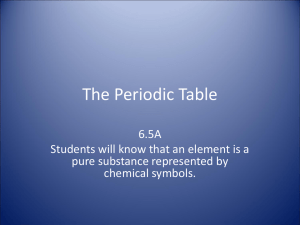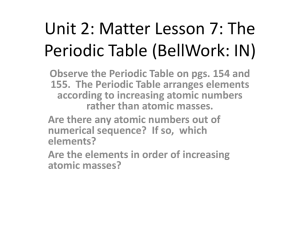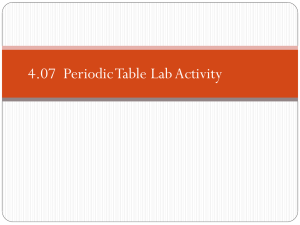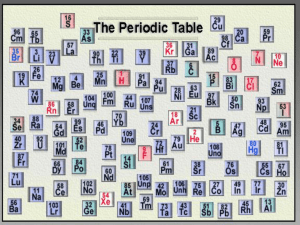Elements and the Periodic Table
advertisement
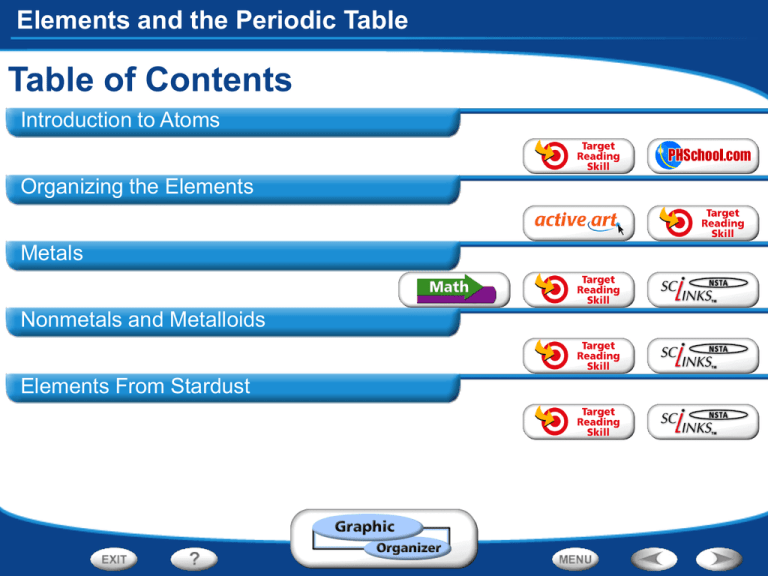
Elements and the Periodic Table Table of Contents Introduction to Atoms Organizing the Elements Metals Nonmetals and Metalloids Elements From Stardust Elements and the Periodic Table Introduction to Atoms Activities Size of atom- Cut the paper IN HALF as many times as you can until the paper is too small to cut. Note that you will only be cutting half of the piece of paper from before in half each time. An Analogy to Discovering Atoms Using Indirect ObservationsObtain a few ob-scertainers and listen to the BB roll around inside and determine the shape inside. Choose from the 12 shapes on the white board. Write the predicted shape and container number in your lab notebook until you have all 12. Elements and the Periodic Table Learning Objectives 1. Describe the structure of atoms. • Location of protons, neutrons, & electrons • Charges of protons, neutrons, & electrons • Relative mass of protons, neutrons, & electrons 2. Describe elements in terms of their atoms. 3. Explain how models are useful for studying atoms. Elements and the Periodic Table - Introduction to Atoms Models of Atoms For over two centuries, scientists have created models of atoms in an effort to understand why matter behaves as it does. As scientists have learned more, the model of the atom has changed, since atoms are so small that they cannot be observed directly. Carbon atom Elements and the Periodic Table Atomic Theory and Models Dalton thought that atoms were like smooth, hard spheres that could not be broken into smaller pieces. Elements and the Periodic Table Atomic Theory and Models Thomson suggested that atoms had negatively charged electrons embedded in a positive sphere. Elements and the Periodic Table Atomic Theory and Models Rutherford was surprised that a few particles were deflected strongly. This led him to propose an atomic model with a positively charged nucleus. Elements and the Periodic Table Atomic Theory and Models Neils Bohr suggested that the electrons orbited around the nucleus in certain energy levels called shells. He stated that atoms absorb or give off energy when electrons move from one shell to another. Elements and the Periodic Table - Introduction to Atoms Structure of an Atom A carbon atom (and all atoms but hydrogen atoms) consist of protons and neutrons in a nucleus that is surrounded by a cloud-like region of electrons. Carbon atom Elements and the Periodic Table All elements (and all matter) are made up of extremely small A. nuclei B. atoms C. Large particles Elements and the Periodic Table The center of an atom is called the A. B. C. D. protons nucleus neutrons electrons Elements and the Periodic Table The nucleus of almost every atom consists of A. B. C. D. Protons and electrons Just neutrons Protons and neutrons Just protons Elements and the Periodic Table The subatomic particles that move around the nucleus quickly are called A. B. C. D. electrons neutrons protons quarks Elements and the Periodic Table Which of the following correctly describes each subatomic particle in terms of its charge? A. Protons (0 or no charge), Neutrons (0 or no charge), Electrons (-) B. Protons (+), Neutrons (-), Electrons (0 or no charge) C. Protons (-), Neutrons (+), Electrons (0 or no charge) D. Protons (+), Neutrons (0 or no charge), Electrons (-) Elements and the Periodic Table What is the overall electrical charge of an atom with 12 protons and 10 electrons A. B. C. D. E. -2 +2 0 +12 -10 Elements and the Periodic Table Atoms are mostly A. B. C. D. Protons and neutrons Empty space Electrons Protons, Neutrons, & Electrons Elements and the Periodic Table Learning Objective Describe elements in terms of their atoms. – Number of protons, neutrons, & electrons – Overall charge of the atom – Atomic mass or the Atom’s Mass Number – Atomic Number & Identity Elements and the Periodic Table Atomic Easter Egg Hunt Experiment Goal- Determine the number of protons (atomic number), number of neutrons, atomic mass, and identity of the nucleus of 5 different atoms for 5 different elements. Background (Periodic Table on page 84 and 85 in your textbook): Orange BB’s = protons and Green BB’s = neutrons • Number of protons + number of neutrons = atomic mass (because protons and neutrons are 1 mass unit each). • Number of protons = atomic number (found above the element’s symbol in the center for the table in your book). Color(s) Green Orange Yellow Purple A Purple B # of protons # of neutrons Atomic Mass Atomic Number Identity Elements and the Periodic Table - Introduction to Atoms Atoms, Elements, & Isotopes • Atomic Number determines the identity which equals the number of protons. The number of neutrons + the number of protons equals the mass number because each have a mass of 1 atomic mass unit. • Atoms of all isotopes of carbon contain six protons, but they differ in the number of neutrons. • Carbon-12 is the most common form of carbon, where the 12 is the mass number. Examine the symbols below. (6 = atomic number = # of protons; 12, 13, and 14 = atomic mass = # of protons + # of neutrons). •Notice that all of the isotopes (and atoms) are neutral (same # of protons and electrons). Elements and the Periodic Table Atoms & Elements Flow Chart He-4 Identity Find on Periodic Table Find Atomic number above symbol Atomic Number = # of protons # of electrons = # of protons for neutral atoms Atomic Mass Mass = # of protons + # of neutrons (both 1 mass unit each) Atomic Mass MINUS the # of protons = # of neutrons Elements and the Periodic Table Practice Problems 1. For a neutral Ne-22 atom, determine the… a) Identity b) Atomic Mass c) Atomic Number d) # of p+ e) # of n0 f) # of e2. For a neutral F-19 atom, determine a-f from above. Elements and the Periodic Table The atomic number of an element is the same as the A. Number of protons & neutrons in the nucleus of that atom. B. Number of protons in the nucleus of that atom. C. Number of neutrons in the nucleus of that atom. D. Number of electrons in the nucleus of that atom. Elements and the Periodic Table The atomic number determines the __________ of an atom. A. B. C. D. identity mass Number of neutrons Number of subatomic particles Elements and the Periodic Table Protons and neutrons are both A. B. C. D. 2 atomic mass units each. 0 atomic mass units each. 1 atomic mass unit each. 0.5 atomic mass units each. Elements and the Periodic Table What 2 subatomic particles make up most of the mass of an atom? A. B. C. D. Protons and neutrons. Protons and electrons. Just neutrons. Neutrons and electrons. Elements and the Periodic Table For a Nitrogen-14 atom, what does the 14 represent? A. B. C. D. Atomic number of proton number Mass number or atomic mass Atomic particle number The atom’s identity Elements and the Periodic Table Determine the number of protons for a hydrogen-3 atom. A. B. C. D. 1 2 3 0 Elements and the Periodic Table Determine the number of neutrons for a hydrogen-3 atom. A. B. C. D. 1 2 3 0 Elements and the Periodic Table Determine the number of electrons for a neutral hydrogen-3 atom. Provide the overall charge of the atom too. A. B. C. D. E. 1 electron; No charge 1 electron; -1 2 electrons; -1 3 electrons; No charge 1 electron; +1 Elements and the Periodic Table Practice Problems 1. Determine the atomic number and the atomic mass for an atom that has 8 protons and 8 neutrons. 2. What is the identity of this atom? 3. Suppose an atom has 6 protons and 8 neutrons, what is the atomic number and the identity of this atom? 4. What is the name given to the type of atom in the question above and WHY? Hint: Look at the number of protons and neutrons and think about the term for these types of atoms we covered yesterday. 5. Chlorine-37 is an isotope of chlorine. How many protons, neutrons, and electrons does it have? 6. What is Chlorine-37's atomic number? 7. Potassium-40 is a radioactive isotope of potassium (a very small amount can be found in bananas but it doesn’t harm you). How many protons, neutrons, and electrons does potassium-40 have? 8. What is Potassium-40’s atomic number? Elements and the Periodic Table Practice Problem Answers 1. 8 (Atomic Number), 16 (Atomic Mass) 2. Oxygen-16 3. 6 (Atomic Number), Carbon-14 4. Isotope- Same # of protons, but a different number of neutrons 5. Chlorine-37: 17 protons (Atomic #), 20 neutrons (Mass – Atomic #), 17 electrons (Same as # of protons b/c it’s neutral) 6. Chlorine-37: Atomic Number = 17 7. Potassium-40: 19 protons (Atomic #), 21 neutrons (Mass - # of protons), 19 electrons (same as # of protons b/c it’s neutral) 8. K-40: Atomic Number = 19 Elements and the Periodic Table Noggin Knockers Quiz (13 points- 1 pt. per part) 1. Isotopes 2. a-f (center) and 3. a-f (bottom right) a) Potassium b) 19 c) 19 d) 19 e) 39 f) 20 a) Oxygen b) 8 c) 8 d) 8 e) 18 f) 10 Elements and the Periodic Table Learning Objectives 1. Explain how Mendeleev discovered the pattern that led to the periodic table. 2. Describe the data about elements that are found in the periodic table. 3. Describe how the organization of the periodic table is used to predict the properties of elements. Elements and the Periodic Table - Organizing the Elements Finding Data on Elements Each square of the periodic table includes an element’s atomic number, chemical symbol, name, and average atomic mass. The atomic mass contains a decimal because it is an average of all of the isotopes that occur in the real world. Name of Isotope Mass (amu) % Abundance Chlorine-35 35 75.78% Chlorine-37 37 24.22% Weighted Average 35.5 (on periodic table) Rounding the average atomic mass will almost always give you the mass of the most common isotope of that element. Average Elements and the Periodic Table By examining the element block for Magnesium on p. 84 & 85, what is the elemental symbol for Magnesium? A. B. C. D. Ca M Mg Na Elements and the Periodic Table By examining the element block for Magnesium on p. 84 & 85, what is its atomic number? A. B. C. D. 24.305 12 2 3 Elements and the Periodic Table By examining the element block for Magnesium on p. 84 & 85, what is the average atomic mass for Magnesium? A. B. C. D. 12 2 24.305 3 Elements and the Periodic Table By examining the element block for Magnesium (Mg) on p. 84 & 85, what is the main reason why magnesium’s atomic mass is NOT a whole number? A. b/c protons and neutrons don’t weight exactly 1 mass unit each. B. b/c it’s the number of protons + the number of neutrons. C. b/c it doesn’t include the mass of the electrons. D. b/c it’s a weighted average of the isotopes that occur naturally. Elements and the Periodic Table What’s probably the most common isotope of Neon (#10)? A. B. C. D. Neon-10 Neon-20.179 Neon-20 N-10 Elements and the Periodic Table What’s probably the most common isotope of Argon (#18)? A. B. C. D. Argon-36 Argon-38 Argon-39 Argon-40 Elements and the Periodic Table Noggin Knockers/Hwk. Grade (12 points) 1 (3 points)- protons (+), neutrons (0 or neutral), electrons (-) 2 (2 points)- b/c there is an equal number of positive charges (protons) and negative charges (electrons) 3 N-15: (6 points)(a) Nitrogen (b) Atomic # = 7 (c) 7 protons (d) 7 electrons (same as # of protons, overall charge = 0) (e) Mass = 15 amu (f) 8 neutrons (Mass - # of protons = 15-7 = 8), 4 (1 point)- Atoms are too small to see even with a powerful microscope Elements and the Periodic Table Learning Objectives 1. Explain how Mendeleev discovered the pattern that led to the periodic table. 2. Describe the data about elements that are found in the periodic table. 3. Describe how the organization of the periodic table is used to predict the properties of elements. Elements and the Periodic Table Chemical Properties of Some Elements Goal: (Use the title to determine the goal) Conclusions (Periodic Table Trends) Examine the columns in the periodic table that contain the elements to the right and your observations from the experiment. 1. Elements in the same group or column have ____________ properties. (Similar or different) Data Table Name of Element & Group/Column Magnesium (Group II or 2) + Water Calcium (Group II or 2) + Water 2. As you go _________ (direction- use your observations for magnesium and calcium along with their locations on the periodic table) Aluminum (Group IIIA or 13) + Water and to the ___________ (different directionuse the sodium demo & its location on the Lithium (Group I or 1) + periodic table), the elements become more reactive. Water After watching the reaction videos… Sodium (Group I or 1) + 3. Vice versa, as you go _________ (direction) Water and way over to the ___________ (different direction), the elements also are more reactive (not counting the column or group all the way Potassium (Group I or 1) to the right). + Water Observations Elements and the Periodic Table - Organizing the Elements Organization of the Periodic Table •Elements in a column or group also typically have similar properties. •Examples- Sodium and Lithium reacting with water. Chlorine and bromine gases are both harmful to your lungs. •The 18 columns of the periodic table reflect a repeating pattern of properties that generally occur across a period. Elements and the Periodic Table Mendeleev & the Periodic Table Mendeleev originally noticed a repeating pattern of properties (both chemical and physical) when he placed the elements in order of atomic mass, unlike today’s periodic table. How is today’s periodic table arranged? By atomic number (same as the number of protons) Elements and the Periodic Table - Metals Melting Points in a Group of Elements The properties of elements within a single group in the periodic table often vary in a certain pattern. The following graph shows the melting points of Group 1 elements (alkali metals) from lithium to francium. Elements and the Periodic Table - Metals Metals in the Periodic Table The metals in Group 1, from lithium to francium, are the most reactive metals and are called the alkali metals. Alkali metals react with atoms of other elements by losing one electron. Elements and the Periodic Table - Metals Metals in the Periodic Table Group 2 of the periodic table contains the alkaline earth metals. These elements are not as reactive as the metals in Group 1, but they are more reactive than most other metals. Elements and the Periodic Table - Metals Metals in the Periodic Table •The transition metals are less reactive than the metals in Groups 1 and 2. All metals are typically shiny, malleable (can be hammered into flat sheets), ductile (made into a long wire), and can conduct electricity. •Also, the reactivity of metals decreases as you go across a row in the periodic table. Elements and the Periodic Table - Metals Metals in the Periodic Table Only some of the elements in Groups 13 through 15 of the periodic table are metals. These metals are not nearly as reactive as those on the left side of the table. Elements and the Periodic Table - Metals Metals in the Periodic Table •Lanthanides are soft, malleable, shiny metals with high conductivity. Elements and the Periodic Table - Metals Metals in the Periodic Table •The elements below the lanthanides are called actinides. Many of these elements are so unstable that they last for only a fraction of a second after they are made. •The metals that follow uranium are man-made (synthetic) by forcing nuclear particles to collide with one another. Elements and the Periodic Table - Nonmetals and Metalloids Families of Nonmetals The Group 17 elements are the most reactive nonmetals. Atoms of these elements easily form compounds by sharing or gaining one electron when reacting with atoms of other elements. Elements and the Periodic Table - Nonmetals and Metalloids Families of Nonmetals The elements in Group 18 are known as the noble gases. They do not ordinarily form compounds because atoms of noble gases do not usually gain, lose, or share electrons. - Atoms,Table Bonding, and the Periodic Table Elements and the Periodic The Periodic Table The variety of colors in a “neon” sign results from passing an electric current through sealed glass tubes containing different noble gases. Elements and the Periodic Table The modern periodic table is arranged according to atomic _________, while the older periodic table was arranged according to atomic _______. A. B. C. D. Mass; number Number; mass Number; number Mass; mass Elements and the Periodic Table A group or family on the periodic table is the same as a A. B. C. D. Horizontal row. Vertical column. Horizontal column. Vertical row. Elements and the Periodic Table Elements in the same group or column tend to have ________ properties. A. B. C. D. The same different similar Completely different Elements and the Periodic Table As you move across a row or period on the periodic table the properties of the elements tend to A. B. C. D. Stay the same. Change gradually. Remain similar the whole way across. Be completely different. Elements and the Periodic Table What would be an element with similar properties to oxygen (#8)? A. B. C. D. Calcium (#20) Fluorine (#9) Nitrogen (#7) Sulfur (#16) Elements and the Periodic Table Which group on the periodic table contains elements that are highly reactive metals when combined with water? A. B. C. D. Group 2 Group 13 Group 17 Group 1 Elements and the Periodic Table Which group contains highly reactive gases? A. B. C. D. Group 1 Group 17 Group 16 Group 18 Elements and the Periodic Table Which group contains non-reactive elements? A. B. C. D. Group 1 Groups 3-12 Group 17 Group 18 Elements and the Periodic Table Noggin Knockers (Hwk. Grade- 10 points) 1 (2 points)- The old table was arranged according to atomic mass while the new one was arranged according to atomic number. 2 (1 point)- Silver 3 (2 points)- The masses on the table are a weighted average of the isotopes that occur naturally. 4 (2 points- 1 point for each correct element)- Magnesium, Strontium, Barium, Radium, or Beryllium 5 (1 point)- Group 1 6 (1 point)- Group 17 7 (1 point)- Group 18 Elements and the Periodic Table Elements & the Periodic Table Practice Test Answers 1. Atoms; models 2. Nucleus 3. Protons and Neutrons- in the nucleus; electrons- outside the nucleus 4. Protons (+), Neutrons (0), Electrons (-) 5. Number 6. For an Ar-40 atom: Protons = 18, Neutrons = 22, Electrons = 18 7. 40 = Atom’s Mass 8. Neutral or 0, b/c the # or protons = # of electrons: +18 + (-18) = 0 Elements and the Periodic Table Elements & the Periodic Table Practice Test Answers 9. Isotopes 10. The mass on the table is an average of all of argon’s isotopes. 11. Old = Atomic Mass, New = Atomic Number 12. Groups or Families 13. Similar 14. Group 1 15. Group 17 16. Group 18 17. Gold, Cobalt, Copper, Titanium, Nickel, etc. 18. (A) Argon- Neon, any element in group 18 (B) Iodine- Bromine, any element in group 17 (C) Americium- Plutonium, any element nearby Elements and the Periodic Table - Organizing the Elements Periodic Table Activity Click the Active Art button to open a browser window and access Active Art about the periodic table. Elements and the Periodic Table - Organizing the Elements Asking Questions Before you read, preview the red headings. In a graphic organizer like the one below, ask a what or how question for each heading. As you read, write answers to your questions. Question Answers What pattern of elements did Mendeleev discover? Patterns appeared when the elements were arranged in order of increasing atomic mass. What data about elements is found in the periodic table? Atomic number, chemical symbols and names, and average atomic mass How are elements organized in the periodic table? Elements are organized in periods and groups based on their properties. Elements and the Periodic Table End of Section: Organizing the Elements Elements and the Periodic Table - Metals Metals in the Periodic Table The metals in Group 1, from lithium to francium, are called the alkali metals. Alkali metals react with atoms of other elements by losing one electron. Elements and the Periodic Table - Metals Metals in the Periodic Table Group 2 of the periodic table contains the alkaline earth metals. These elements are not as reactive as the metals in Group 1, but they are more reactive than most other metals. Elements and the Periodic Table - Metals Melting Points in a Group of Elements The properties of elements within a single group in the periodic table often vary in a certain pattern. The following graph shows the melting points of Group 1 elements (alkali metals) from lithium to francium. Elements and the Periodic Table - Metals Melting Points in a Group of Elements Reading Graphs: As you look at Group 1 from lithium to francium, describe how the melting points of the alkali metals change. Melting points decrease from lithium to francium. Elements and the Periodic Table - Metals Melting Points in a Group of Elements Predicting: If element number 119 were synthesized, it would fall below francium in Group 1 of the periodic table. Predict the approximate melting point of new element 119. New element 119 should have a melting point of approximately 25ºC. Elements and the Periodic Table - Metals Melting Points in a Group of Elements Interpreting Data: Room temperature is usually about 22ºC. Human body temperature is 27ºC. Which of the alkali metals are liquids at room temperature? Which might melt if you could hold them in your hand? None of the alkali metals are liquids at room temperature. Cesium and francium might melt if you could hold them in your hand. Elements and the Periodic Table - Metals Metals in the Periodic Table •The transition metals are less reactive than the metals in Groups 1 and 2. All metals are typically shiny, malleable (can be hammered into flat sheets), ductile (made into a long wire), and can conduct electricity. •Also, the reactivity of metals decreases as you go across a row in the periodic table. Elements and the Periodic Table - Metals Metals in the Periodic Table Only some of the elements in Groups 13 through 15 of the periodic table are metals. These metals are not nearly as reactive as those on the left side of the table. Elements and the Periodic Table - Nonmetals and Metalloids Families of Nonmetals The Group 17 elements are the most reactive nonmetals. Atoms of these elements easily form compounds by sharing or gaining one electron when reacting with atoms of other elements. Elements and the Periodic Table - Metals Metals in the Periodic Table •Lanthanides are soft, malleable, shiny metals with high conductivity. Elements and the Periodic Table - Metals Metals in the Periodic Table •The elements below the lanthanides are called actinides. Many of these elements are so unstable that they last for only a fraction of a second after they are made. •The metals that follow uranium are man-made (synthetic) by forcing nuclear particles to collide with one another. Elements and the Periodic Table - Metals Using Prior Knowledge Before you read, write what you know about metals in a graphic organizer like the one below. As you read, write what you learn. What You Know 1. 2. Metals are shiny. Some metals are magnetic. What You Learned 1. 2. Ductile metals can be pulled into a wire. Alkali metals react by losing one electron. Elements and the Periodic Table - Metals Links on Metals Click the SciLinks button for links on metals. Elements and the Periodic Table End of Section: Metals Elements and the Periodic Table - Nonmetals and Metalloids Properties of Nonmetals •Non-metals are typically dull & brittle (if they’re solid non-metals) and poor conductors of heat and electricity, but they are fairly reactive with other elements. •When nonmetals react with metals, one or more electrons move from the metal atoms to the nonmetal atoms. Elements and the Periodic Table - Nonmetals and Metalloids Families of Nonmetals Each element in the carbon family has atoms that can gain, lose, or share four electrons when reacting with atoms of other elements. Elements and the Periodic Table - Nonmetals and Metalloids Families of Nonmetals Group 15, the nitrogen family, contains two nonmetals: nitrogen and phosphorus. These nonmetals usually gain or share three electrons when reacting with atoms of other elements. Elements and the Periodic Table - Nonmetals and Metalloids Families of Nonmetals Group 16, the oxygen family, contains three nonmetals: oxygen, sulfur, and selenium. These elements usually gain or share two electrons when reacting with atoms of other elements. Elements and the Periodic Table - Nonmetals and Metalloids Families of Nonmetals The Group 17 elements are the most reactive nonmetals. Atoms of these elements easily form compounds by sharing or gaining one electron when reacting with atoms of other elements. Elements and the Periodic Table - Nonmetals and Metalloids Families of Nonmetals The elements in Group 18 are known as the noble gases. They do not ordinarily form compounds because atoms of noble gases do not usually gain, lose, or share electrons. Elements and the Periodic Table - Nonmetals and Metalloids Families of Nonmetals Because the chemical properties of hydrogen differ very much from those of the other elements, it really cannot be grouped into a family. Elements and the Periodic Table - Nonmetals and Metalloids The Metalloids The metalloids have some characteristics of both metals and nonmetals. The most useful property of the metalloids is their varying ability to conduct electricity. Elements and the Periodic Table - Nonmetals and Metalloids Using Prior Knowledge Before you read, write what you know about nonmetals in a graphic organizer like the one below. As you read, write what you learn. What You Know 1. 2. Nonmetals are not shiny. Nonmetals are not magnetic. What You Learned 1. 2. Nonmetals are dull and brittle. Metalloids have characteristics of metals and nonmetals. Elements and the Periodic Table - Nonmetals and Metalloids Links on Nonmetals Click the SciLinks button for links on nonmetals. Elements and the Periodic Table End of Section: Nonmetals and Metalloids Elements and the Periodic Table - Elements From Stardust How Elements Form in Stars Nuclear fusion, which occurs in stars on a huge scale, combines smaller nuclei into larger nuclei, creating heavier elements. Elements and the Periodic Table - Elements From Stardust Sequencing As you read, make a flowchart like the one below that shows how elements are formed in stars. Write the steps in separate boxes in the flowchart in the order in which they occur. Hydrogen nuclei fuse, forming helium. Helium nuclei fuse, forming beryllium. Fusion continues in smaller stars, forming elements up to oxygen. Fusion in larger stars produces heavier elements up to iron. The heaviest elements form during supernova explosions of the most massive stars. Elements and the Periodic Table - Elements From Stardust Links on Nuclear Fusion Click the SciLinks button for links on nuclear fusion. Elements and the Periodic Table End of Section: Elements From Stardust Elements and the Periodic Table Graphic Organizer Periodic table is made up of organizes Elements Rows Columns in order of increasing called called Atomic number Periods Families and shows or Patterns of properties Groups Elements and the Periodic Table End of Section: Graphic Organizer


